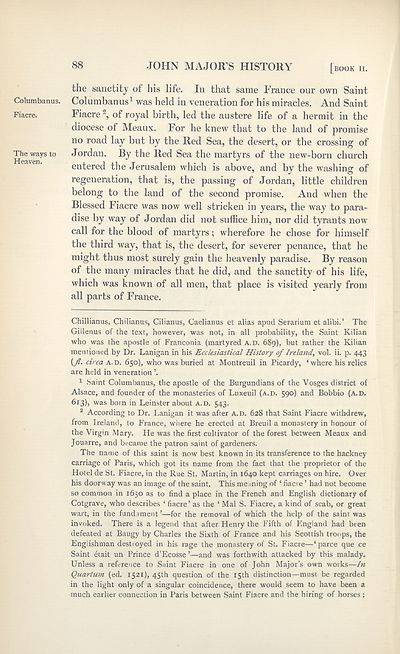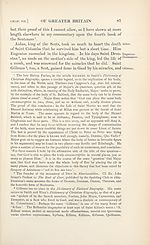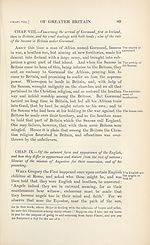Series 1 > History of Greater Britain, as well England as Scotland
(233) Page 88
Download files
Complete book:
Individual page:
Thumbnail gallery: Grid view | List view

88 JOHN MAJOR’S HISTORY [book ii.
the sanctity of his life. In that same France our own Saint
Columbanus. Columbanus1 was held in veneration for his miracles. And Saint
Fiacre. Fiacre 2, of royal birth, led the austere life of a hermit in the
diocese of Meaux. For he knew that to the land of promise
no road lay but by the Red Sea, the desert, or the crossing of
The ways to Jordan. By the Red Sea the martyrs of the new-born church
e ' entered the Jerusalem which is above, and by the washing of
regeneration, that is, the passing of Jordan, little children
belong to the land of the second promise. And when the
Blessed Fiacre was now well stricken in years, the way to para¬
dise by way of Jordan did not suffice him, nor did tyrants now
call for the blood of martyrs; wherefore he chose for himself
the third way, that is, the desert, for severer penance, that he
might thus most surely gain the heavenly paradise. By reason
of the many miracles that he did, and the sanctity of his life,
which was known of all men, that place is visited yearly from
all parts of France.
Chillianus, Chilianus, Cilianus, Caelianus et alias apud Serariutn et alibi.’ The
Gillenus of the text, however, was not, in all probability, the Saint Kilian
who was the apostle of Franconia (martyred a.d. 689), but rather the Kilian
mentioned by Dr. Lanigan in his Ecclesiastical History of Ireland, vol. ii. p. 443
(fl. circa a. D. 650), who was buried at Montreuil in Picardy, ‘ where his relics
are held in veneration ’.
1 Saint Columbanus, the apostle of the Burgundians of the Vosges district of
Alsace, and founder of the monasteries of Luxeuil (a.d. 590) and Bobbio (a.d.
StS)) was born in Leinster about A.D. 543.
2 According to Dr. Lanigan it was after a.d. 628 that Saint Fiacre withdrew,
from Ireland, to France, where he erected at Breuil a monastery in honour of
the Virgin Mary. He was the first cultivator of the forest between Meaux and
Jouarre, and became the patron saint of gardeners.
The name of this saint is now best known in its transference to the hackney
carriage of Paris, which got its name from the fact that the proprietor of the
Hotel de St. Fiacre, in the Rue St. Martin, in 1640 kept carriages on hire. Over
his doorway was an image of the saint. This meaning of ‘ fiacre ’ had not become
so common in 1650 as to find a place in the French and English dictionary of
Cotgrave, who describes ‘ fiacre ’ as the ‘ Mai S. Fiacre, a kind of scab, or great
wart, in the fundament ’—for the removal of which the help of the saint was
invoked. There is a legend that after Henry the Fifth of England had been
defeated at Baugy by Charles the Sixth of Fiance and his Scottish troops, the
Englishman destroyed in his rage the monastery of St. Fiacre—‘parce que ce
Saint etait un Prince d’Ecosse ’—and was forthwith attacked by this malady.
Unless a reference to Saint Fiacre in one of John Major’s own works—In
Quantum (ed. 1521), 45th question of the 15th distinction—must be regarded
in the light only of a singular coincidence, there would seem to have been a
much earlier connection in Paris between Saint Fiacre and the hiring of horses;
the sanctity of his life. In that same France our own Saint
Columbanus. Columbanus1 was held in veneration for his miracles. And Saint
Fiacre. Fiacre 2, of royal birth, led the austere life of a hermit in the
diocese of Meaux. For he knew that to the land of promise
no road lay but by the Red Sea, the desert, or the crossing of
The ways to Jordan. By the Red Sea the martyrs of the new-born church
e ' entered the Jerusalem which is above, and by the washing of
regeneration, that is, the passing of Jordan, little children
belong to the land of the second promise. And when the
Blessed Fiacre was now well stricken in years, the way to para¬
dise by way of Jordan did not suffice him, nor did tyrants now
call for the blood of martyrs; wherefore he chose for himself
the third way, that is, the desert, for severer penance, that he
might thus most surely gain the heavenly paradise. By reason
of the many miracles that he did, and the sanctity of his life,
which was known of all men, that place is visited yearly from
all parts of France.
Chillianus, Chilianus, Cilianus, Caelianus et alias apud Serariutn et alibi.’ The
Gillenus of the text, however, was not, in all probability, the Saint Kilian
who was the apostle of Franconia (martyred a.d. 689), but rather the Kilian
mentioned by Dr. Lanigan in his Ecclesiastical History of Ireland, vol. ii. p. 443
(fl. circa a. D. 650), who was buried at Montreuil in Picardy, ‘ where his relics
are held in veneration ’.
1 Saint Columbanus, the apostle of the Burgundians of the Vosges district of
Alsace, and founder of the monasteries of Luxeuil (a.d. 590) and Bobbio (a.d.
StS)) was born in Leinster about A.D. 543.
2 According to Dr. Lanigan it was after a.d. 628 that Saint Fiacre withdrew,
from Ireland, to France, where he erected at Breuil a monastery in honour of
the Virgin Mary. He was the first cultivator of the forest between Meaux and
Jouarre, and became the patron saint of gardeners.
The name of this saint is now best known in its transference to the hackney
carriage of Paris, which got its name from the fact that the proprietor of the
Hotel de St. Fiacre, in the Rue St. Martin, in 1640 kept carriages on hire. Over
his doorway was an image of the saint. This meaning of ‘ fiacre ’ had not become
so common in 1650 as to find a place in the French and English dictionary of
Cotgrave, who describes ‘ fiacre ’ as the ‘ Mai S. Fiacre, a kind of scab, or great
wart, in the fundament ’—for the removal of which the help of the saint was
invoked. There is a legend that after Henry the Fifth of England had been
defeated at Baugy by Charles the Sixth of Fiance and his Scottish troops, the
Englishman destroyed in his rage the monastery of St. Fiacre—‘parce que ce
Saint etait un Prince d’Ecosse ’—and was forthwith attacked by this malady.
Unless a reference to Saint Fiacre in one of John Major’s own works—In
Quantum (ed. 1521), 45th question of the 15th distinction—must be regarded
in the light only of a singular coincidence, there would seem to have been a
much earlier connection in Paris between Saint Fiacre and the hiring of horses;
Set display mode to:
![]() Universal Viewer |
Universal Viewer | ![]() Mirador |
Large image | Transcription
Mirador |
Large image | Transcription
Images and transcriptions on this page, including medium image downloads, may be used under the Creative Commons Attribution 4.0 International Licence unless otherwise stated. ![]()
| Scottish History Society volumes > Series 1 > History of Greater Britain, as well England as Scotland > (233) Page 88 |
|---|
| Permanent URL | https://digital.nls.uk/127734561 |
|---|
| Attribution and copyright: |
|
|---|
| Description | Over 180 volumes, published by the Scottish History Society, containing original sources on Scotland's history and people. With a wide range of subjects, the books collectively cover all periods from the 12th to 20th centuries, and reflect changing trends in Scottish history. Sources are accompanied by scholarly interpretation, references and bibliographies. Volumes are usually published annually, and more digitised volumes will be added as they become available. |
|---|


